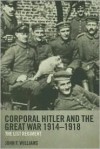Currently reading
AN AIRMAN'S TALE FROM A CENTURY AGO

As a First World War aviation enthusiast of 40 years standing (I bought my first book on the subject when I was a preteen in April 1977), I had known about "FIGHTING THE FLYING CIRCUS" for some time. But it was only a few days ago that I at long last made the time to read it. And truly it is a fantastic story.
Before enlisting in the U.S. Army in 1917, Eddie Rickenbacker had achieved national renown as an auto racer. Though he had little formal education (comparatively most of his squadron mates were college or university students or graduates), he had worked at a variety of jobs and had become a skilled mechanic with a deep, intimate knowledge of engines. Rickenbacker managed to transfer into the U.S. Army Air Service (USAS), received his flight training in France, and was assigned in March 1918 to the newly established 94th Aero Squadron - one of 2 U.S. trained fighter units on the Western Front at that time.
In the book, Rickenbacker shares with the reader the full scope of his combat experiences. Despite the 94th Aero Squadron lacking armament for its fighters when first activated for combat, it began flying over the lines to give its pilots a feel for the challenges and perils of frontline flying. Rickenbacker flew many of his first combat missions with who was then America's leading fighter ace, Raoul Lufbery, who had had extensive experience flying with the Escadrille Lafayette in France's Aéronautique Militaire during 1916 and 1917. Lufbery had been brought over to the 94th as a steadying influence after transferring to the USAS. For instance, in describing his first experience with German anti-aircraft fire (dubbed 'Archy'), Rickenbacker admitted that "[n]ever before did I, and never again will I quite so much appreciate the comfort of having a friend near at hand. I suddenly noticed that Major Lufbery was alongside me. Almost subconsciously I followed his maneuvers and gradually I began to realize that each maneuver he made was a direct word of encouragement to me. His machine seemed to speak to me, to soothe my feeling, to prove to me that there was no danger so long as I followed its wise leadership."
This marked the beginning of a long and overarching learning curve for Rickenbacker. And as a reader, it was fascinating to see how he developed in skill, confidence, and knowledge over the following months. The 94th Aero Squadron would, after flying a few weeks lacking armament, acquire machine guns for its Nieuport 28 fighters (the unit would be re-equipped with the robust and redoubtable SPAD XIII fighter by August 1918), and be in the vanguard of the American Expeditionary Force (AEF) in its offensive actions against the Germans during the summer and fall of 1918. By war's end, Rickenbacker would be commanding the 94th, having scored 26 confirmed victories. (The 94th Aero Squadron would emerge by November 11, 1918 as the top scorer among the 20 U.S. fighter squadrons in France.)
This is a book in which Rickenbacker shares with the reader the full gamut of life at the Front as he lived and experienced it. He speaks in considerable detail about his combat missions, which read like something out of the movie, "The Blue Max" --- flying through barrages of 'Archy' above the trenches, as well as the thrills and perils of aerial combat. Rickenbacker also conveys the pain and sorrow from losing friends in battle --- such as his buddy Hamilton Coolidge, an ace whose SPAD received a direct hit from anti-aircraft fire, disintegrating it in mid-air. This happened less than 2 weeks before the end of the war.
Anyone who has an interest in reading eyewitness accounts from the First World War or like to read thrilling tales of aerial combat will enjoy reading "FIGHTING THE FLYING CIRCUS."
 2
2













